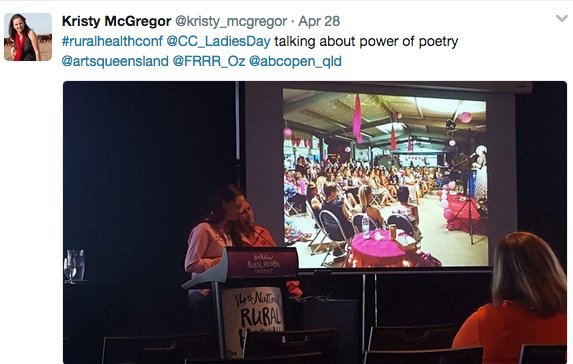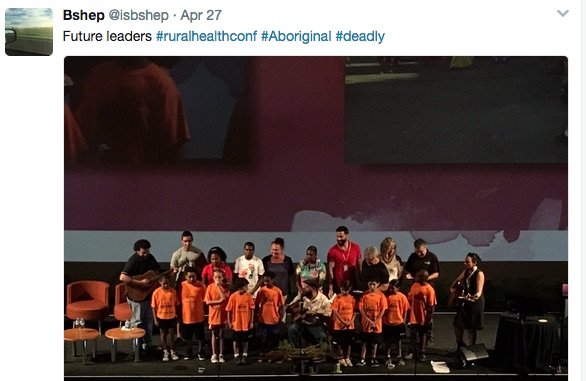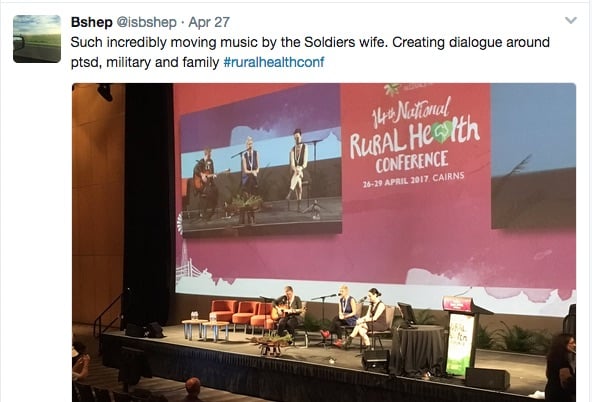After the National Rural Health Conference in 2015, Croakey’s Jennifer Doggett wrote a thoughtful article reflecting on the importance of arts and cultural performances in the conference program.
Shared cultural and creative experiences helped to create a sense of community, make spaces for reflection and rejuvenation, link delegates to the environment, and to share and celebrate the many talents of rural communities, she wrote.
Likewise, the diverse creative talents on display at the recent National Rural Health Conference in Cairns provided many memorable experiences for conference participants, as well as insights into related therapeutic benefits.
One conference highlight came courtesy of Professor Gracelyn Smallwood who, during a plenary session on cultural competence, ended her presentation with a rendition of “Crazy”, accompanied by Dr Mark Wenitong on guitar.

Below, Kristy McGregor, a young rural change maker who now works in New Zealand, shares some of her conference journey through the arts, as well as vignettes from the Channel Country Ladies’ Day, which she helped establish in 2012.
Other creative highlights from #ruralhealthconf are featured beneath her article.
Kristy McGregor writes:
Through the arts and health stream at the National Rural Health Conference, we were taken on a journey.
It was a journey into the lives of people in communities across rural and remote Australia, and a journey to understand the impact of the arts on health and wellbeing.
In Whyalla, South Australia, the power of stand up comedy is creating mental health awareness and reducing stigma. Stand Up for Mental Health was held in 2016, a program supported by a number of health organisations and featuring Canada based counselor and stand-up comic, David Granirer.
Seven comics from Whyalla, Port Augusta and Port Lincoln were trained over 12 weeks. The team on the Eyre Peninsula harnessed the use of digital technology to overcome isolation, with David skyping in before flying over for the final series of workshops and the ultimate conclusion – the performance, where the whole community was invited along.
For Granirer, comedy helps to build self esteem and reduce public stigma around mental illness: “Laughing in the face of pain makes people go from despair to hope, and hope is crucial to anyone struggling with a mental illness”. (Read more in the Whyalla News).

Power of song
At the conference in tropical north Queensland, we heard directly from a group of choir singers: “When you sing as a group, you start to feel you matter”. Another said: “Singing for me is like medicine, I use it everyday to shift moods”. Powerful stuff indeed.
Arts Nexus was established in 1996 and has been working with artists and communities, giving people a voice. Linking with local festivals and events scattered across north Queensland, local communities are supported to grow and thrive.
Down south, in Bundaberg, every weekend people gather in hotels and pubs around the region for the Pub Rock Choir. It’s a fun, social opportunity for people to come together and sing songs that they know and enjoy – and no formal training is necessary. It’s accessible, promotes wellbeing, and is just one of the experiences that Creative Regions has developed, in response to the needs of rural communities.
The team at Creative Regions works with government agencies and industry to understand the big issues affecting communities, and leads arts responses to those issues. And they are passionate about it – they live and breathe their community.
On a summer’s night in January, community members in Bundaberg gathered in front of a makeshift stage of scaffolding, to hear a piece of theatre that has been pulled together by the community over the past year.
Elephant in the Room is a play that highlights common troubles youth face, with challenges of anxiety, social media, relationships woven in. Teenagers, mental health workers, school chaplains, youth at risk and teenagers all helped to bring together the production.
 In the Channel Country
In the Channel Country
And in the Channel Country, it’s the poetic words that speak as 200 women gather at the racetrack of remote Betoota (the smallest gazetted town in Australia).
“On a concrete floor/just before midnight/we dance”.
“Cars parked in the desert/ tents greet women/ secrets are shared”.
As reported for ABC Open, through poetry with artist Emilie Zoey Baker, the women ponder their experience of coming together in the outback for the Channel Country Ladies’ Day.
 I was invited to attend the National Rural Conference in my capacity as co-founder of this event, which has become a staple on the western Queensland calendar.
I was invited to attend the National Rural Conference in my capacity as co-founder of this event, which has become a staple on the western Queensland calendar.
It draws together women from across western Queensland, northern South Australia, and north-west New South Wales. Acknowledging the Indigenous people on the land where we gather, local female elders and female Aboriginal artists are celebrated through the arts program.
When we started Ladies Day in 2012, we thought it was a fun weekend in a tin shed – the hangar on a remote station. And that’s all it was – with a sex toy consultant, a tarot card reader, a visiting author, and a singer, we were all there to have some fun.
Fun we did but the weekend gave so much more. It touched the lives of the women who had travelled hundreds of kilometres to get there.
I recall a moment that weekend when a young woman came up and said to me, it had made her question what she was doing with her life. And it seemed then that this was more than just an opportunity to dress up; this was giving women a place to explore.
The event, now a “fixture on the outback calendar”, is valuable because it is the one opportunity that women in the remote corners of the three states have to make time for themselves. In dresses, heels and some still in their work boots, we all gather at the racetrack for a weekend for us.
Left at home are identities as mothers, wives, cooks, plumbers, teachers, cleaners, ringers, contractors; for one weekend women have the chance to tap into and rediscover what makes them them.
 Pushed out of their comfort zone as they stand on stage to enact a newly prepared comedy routine, as they share a part of themselves with the actors who will play out their lives in playback theatre in the dry creek bed, or as their naked body is painted by the international body painter.
Pushed out of their comfort zone as they stand on stage to enact a newly prepared comedy routine, as they share a part of themselves with the actors who will play out their lives in playback theatre in the dry creek bed, or as their naked body is painted by the international body painter.
This is a chance for women to act as a quiet observer or active participant in new experiences that will challenge how they think about themselves.
Through participation in the performing arts, experiences are shared, stories are told and we all connect, young, old, mothers and daughters, neighbours and friends. At playback, two women shared how working in a dinosaur museum on the bones had got them through depression during the drought. Stories like this connect us all and are raw, honest and real.
Ladies Day doesn’t glorify life in the outback but it celebrates women and allows a place for expression.
I’ve witnessed some beautiful things at Ladies Day. One that sticks prominently in my mind is my friend Bernie cradling her baby on the dance floor at midnight.
As Bernie dances, her baby feeds. It’s a weekend for herself after weeks on end of being at home on the property on her own, with four children in tow ,including one who she has been told has special needs, and running the property while teaching her small children.
She’s only afforded the opportunity because we line up to get her there and for her mother-in-law to mind the children. It takes some quiet words with her husband.
Addressing mental health
Another woman, a young mother, shared that it was the connections she had made at Ladies Day that had gotten her through depression, at a time when she was struggling.
The Channel Country Ladies Day doesn’t do mental health in a way that is explicit. But we offer opportunities for women to talk with mental health professionals in a quiet and confidential manner over the weekend, to be connected with follow up support from professionals, to be able to have an appointment with the female GP so that under the guise of constant headaches or a aches and pains, social and emotional wellbeing can be raised. And for some, just being with other women is all that they need.
We weave women’s health into the program too – so that among silversmithing and circus – health professionals build rapport with local women, so they know who to call when they need to see a physio, or want some nutrition advice for their children.
The women’s health nurse attends each year to provide a valuable service – the dreaded Pap smear – so that there is no excuse even for women who live 450km from the nearest hospital.
As dreaded as is the thought of having a Pap smear in a grader drivers’ mobile camp (yes that’s right), when you’re called up a week later to say you’ve got precancerous cells of the cervix, and shipped off for tests and surgery – as I was after my Pap smear at Ladies Day – then you’re reminded of how important these services are. Suddenly the transformation of a grader camp into a consulting room seems so incredibly ingenious.
The Channel Country Ladies’ Day isn’t like any other event that I’ve heard of or come across. It’s not just women getting together just for a nice lunch, it’s not the same as the rural women’s gatherings that happen once a year in regional centres.
It’s about high quality arts and offerings in the desert. It’s about bringing all these things – guest speakers, beauty treatments, a live band, burlesque – whether by car or by charter flight – to women in the outback.
It’s bringing a catering team 1400km and with their canapés in tow because we want to provide women with gourmet menu that for the first time in a month they haven’t had to cook themselves. It’s created by women in the Channel Country for women in the Channel Country; and so all the finishing touches are there because we know what women are looking for.
When I see the smiles on women’s faces, when I hear the laughter, and when I feel the sense of togetherness that being together with 200 other women on the edge of the desert brings, I know this is a worthy, valuable thing.

Arts for health
With all this in mind, what did I take out of listening to the experiences and stories of arts projects happening across Australia at the National Rural Health Conference?
A total faith that community driven arts projects and events are absolutely necessary for our rural communities to thrive.
And a strong sense that anyone who can see opportunities for change has the ability to make that change. No matter what hat we wear, no matter what status we have, change comes with the tools you have, inspired by the best asset you have – local people.
One of the priority recommendations from the conference was that arts intrinsically improves health through connecting people, opening conversations and delivering physical and psychological benefits, and that a whole of community approach should be central to the strategy.
This isn’t just about creating a new role for an arts worker or artist within a health organisation, but means looking holistically at how arts and health can be interlinked – and how the arts can be used to understand, interpret and deliver critical health messages.
Since the conference, I’ve headed home to New Zealand with new ideas as to how we can link the arts and health in the Channel Country Ladies’ Day, so that link is as strong as ever, and the wellbeing and women’s health outcomes even more pronounced.
And I’m heading home to see how we can use the arts to address some of the issues facing the rural and remote communities with whom I’m working.
If we all could believe in the power we have to make a difference through the arts, then we’d make for a prouder, more colourful and vibrant rural Australia, where people feel connected and as though they belong.
• Kristy McGregor is a young rural change maker, passionate about building vibrant rural communities through the arts and community driven events. Kristy spent a number of years living on a cattle station on the remote Queensland-SA border, and in other remote towns in western Queensland. It was in western Queensland that she was involved co-ordinating a number of arts projects connecting local artists with women across the west, and established the Channel Country Ladies Day in 2012, a project she continues to be involved in and build.
Kristy works in local government and resource management policy, as a Regional Policy Advisor with Federated Farmers of New Zealand, an advocacy organisation for agriculture and rural communities. When not forging new contacts on either side of the Tasman, Kristy is studying for her Masters in AgriScience, with an interest in rural sociology and community development, at Massey University. Most recently, she has co-founded a festival to link community with their local food producers. Despite being based across the Tasman, she still remains closely involved with and committed to remote Australia.

 Follow on Twitter: @kristy_mcgregor
Follow on Twitter: @kristy_mcgregor
Healing songs and more
Melissa Sweet writes:
“Music is a healer, a provider of hope, a means of expression, a mode of storytelling, a way to build bridges, a way to make and preserve memories, and so much more.”
So states the CD cover for “Songs of Murray Street”, which arose out of a healing project for the children and community around Murray Street in Cairns, following a tragedy that took eight childre’s lives in 2014.
Conference participants were privileged to witness the children in action, together with artist Roz Pappalardo. Their songs were written and recorded at the Manoora Community Centre.




The Soldiers Wife project also conveyed the power of songs to share stories and enable healing. The project’s songwriters talked to almost 100 women, aged from 25 to 104, to tell the stories of women whose partners had served in conflict over the past 60 years.



Listen below.
One personal favourite was a listening meditation courtesy of Natalia Mann and her harp, which provided a sensory feast as she played before a backdrop of a giant underwater scene. Bliss!

Sample some of the session below.
Conference participants also learnt about Kid’s Thrive, a Victorian arts and community development organisation committed to child-led social change. The organisation seeks to foster positive outcomes for children and their communities by developing innovative arts and social justice programs in collaboration with specialists in children’s education, health, welfare and cultural diversity.
Kid’s Thrive uses the arts to tackle issues that children experience arising from trauma, disadvantage and cultural conflict, and to expand children’s creativity, communication and social skills.

Warm thanks to Aunty Rhonda Brim and other cultural practitioners from Wuchopperen Health Service for sharing some of their knowledge around weaving as part of the conference.
It’s a privilege to hold knowledge that has been passed down for thousands of years, she says in the interview below. Weaving, an important cultural practice, is relaxing and good for wellbeing, she says.

I joined some other early risers for an enjoyable session of Dance Games with Owen Allen (photo courtesy of Leanne Coleman).
Allen is a physiotherapist who uses dance and physical theatre to encourage middle and older age people into movement (watch the interview below to find out more about his work).

Biddigal Performing Arts shared stories through dance and culture.

Cairns also provided many opportunities for enjoying public arts.

• For more photos and reports from the conference arts program, see our previous “Snaps and Selfies” post.
• Read more about the conference art’s program here.
• Bookmark this link to follow Croakey’s coverage










